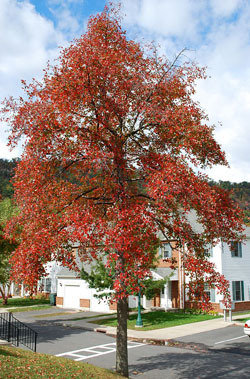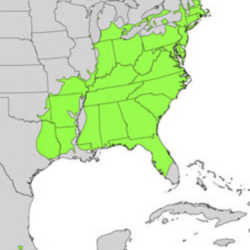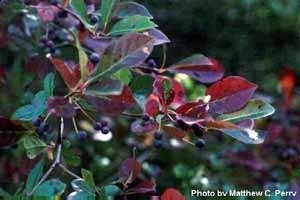





For several years I have enjoyed living in close proximity to a black gum or black tupelo tree. In all seasons, it has something interesting to observe and appreciate.
 Black gum (Nyssa sylvatica) is a member of the Cornaceae (formerly Nyssaceae) family. According to GRIN taxonomy, there are six species of this genus. Known by several common names, including black gum, sourgum, pepperidge, black tupelo, and tupelogum, the tree is native throughout the eastern United States. While best growth is in the southeastern part of the country, it is hardy in USDA Zones 3 to 9.
Black gum (Nyssa sylvatica) is a member of the Cornaceae (formerly Nyssaceae) family. According to GRIN taxonomy, there are six species of this genus. Known by several common names, including black gum, sourgum, pepperidge, black tupelo, and tupelogum, the tree is native throughout the eastern United States. While best growth is in the southeastern part of the country, it is hardy in USDA Zones 3 to 9. 
 The tree is not grown for the beauty of its flowers. As a matter of fact, I seldom notice them. Small and greenish white, the flowers are borne on long stalks in clusters. I may not pay them much attention, but the bees certainly know how to find them. The dark blue oval-shaped half-inch long fruits produced in the autumn are more noticeable than the flowers, and birds spot them right away. High in crude fat, fiber, phosphorus, and calcium, they make a nutritious meal for the avian visitors. Wood of the black gum is heavy and difficult to split. This makes it useful in making such items as pulleys, wheel hubs, and paving blocks. My nephew, who makes wooden bowls and containers, loves to get his hands on a sizeable piece of black gum wood. Some pallets are made of black gum wood, and it can be used as firewood in spite of the difficulty in splitting the wood. Several cultivars of black tupelo exhibit varying characteristics. ‘Autumn Cascades’ and ‘Pendula’ exhibit a weeping form; Red Rage® has bright red fall foliage and is resistant to the leaf spot that mars the beauty of leaves in the species, and the foliage of ‘Wildfire’ emerges deep red before becoming green in summer and changing to tints of orange-yellow to purplish red in autumn. ‘Zydeco Twist’ has slightly contorted, zigzag branches which add winter interest to black gum’s ornamental attributes.
The tree is not grown for the beauty of its flowers. As a matter of fact, I seldom notice them. Small and greenish white, the flowers are borne on long stalks in clusters. I may not pay them much attention, but the bees certainly know how to find them. The dark blue oval-shaped half-inch long fruits produced in the autumn are more noticeable than the flowers, and birds spot them right away. High in crude fat, fiber, phosphorus, and calcium, they make a nutritious meal for the avian visitors. Wood of the black gum is heavy and difficult to split. This makes it useful in making such items as pulleys, wheel hubs, and paving blocks. My nephew, who makes wooden bowls and containers, loves to get his hands on a sizeable piece of black gum wood. Some pallets are made of black gum wood, and it can be used as firewood in spite of the difficulty in splitting the wood. Several cultivars of black tupelo exhibit varying characteristics. ‘Autumn Cascades’ and ‘Pendula’ exhibit a weeping form; Red Rage® has bright red fall foliage and is resistant to the leaf spot that mars the beauty of leaves in the species, and the foliage of ‘Wildfire’ emerges deep red before becoming green in summer and changing to tints of orange-yellow to purplish red in autumn. ‘Zydeco Twist’ has slightly contorted, zigzag branches which add winter interest to black gum’s ornamental attributes.Photo Credits: Thumbnail - the author
Black gum showing fall color - Ahodges-7 on Wikipedia, Public Domain
Range map - U.S. Geological Survey, Public Domain
Branch showing fall color and ripe fruit, Matthew C, Perry, USGS, Wikipedia, Public Domain
Copyright © www.100flowers.win Botanic Garden All Rights Reserved